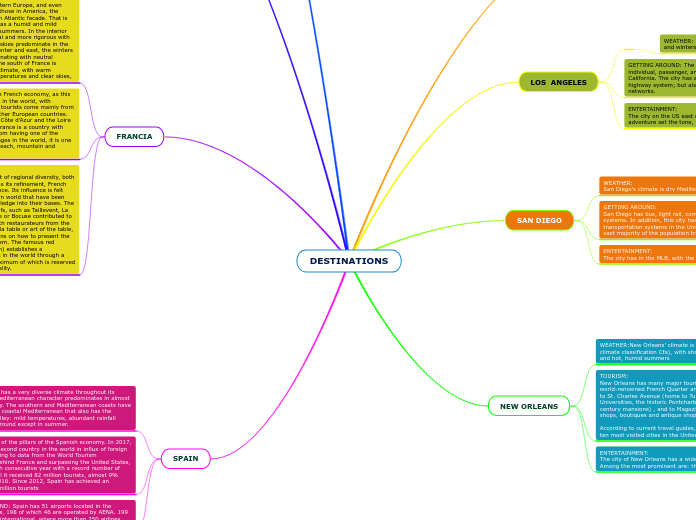DESTINATIONS
AMERICAN CITIES CULTURE
LOS ANGELES
WEATHER: IN Los Angeles, summers are hot, arid, and clear, and winters are long, cool, wet, and partly cloudy.
GETTING AROUND: The city of Los Angeles is a major hub for individual, passenger, and intermodal transportation in California. The city has a complex, extensive and widely used highway system; but also important bus, metro and light rail networks.
ENTERTAINMENT:
The city on the US east coast where film, television and adventure set the tone, the walk of fame, the hollywood sing
SAN DIEGO
WEATHER:
San Diego's climate is dry Mediterranean.
GETTING AROUND:
San Diego has bus, light rail, commuter rail and Amtrak systems. In addition, this city has some of the most developed transportation systems in the United States. Despite this, the vast majority of the population travels by car.
ENTERTAINMENT:
The city has in the MLB, with the San Diego Padres,
NEW ORLEANS
WEATHER:New Orleans' climate is humid subtropical (Köppen climate classification Cfa), with short, generally mild winters and hot, humid summers
TOURISM:
New Orleans has many major tourist attractions, from the world-renowned French Quarter and Bourbon Street nightlife to St. Charles Avenue (home to Tulane and Loyola Universities, the historic Pontchartrain Hotel, and many 19th-century mansions) , and to Magazine Street, with its many shops, boutiques and antique shops.
According to current travel guides, New Orleans is one of the ten most visited cities in the United States
ENTERTAINMENT:
The city of New Orleans has a wide variety of sports teams. Among the most prominent are: the New Orleans SaintS.
EUROPEAN CITIES CULTUREE
LONDRES
WEATHER: London has a temperate oceanic climate, similar to the rest of southern Britain. Despite its reputation as a rainy city, London receives less rainfall in a year than Rome
GETTING AROUND:Transport in the city is one of the four main areas managed by the Mayor of London, 190 although his budgetary powers do not cover the long-distance train network entering the city. In 2007 the Mayor took over responsibility for some local train lines, which now make up the London Overground network, thus adding to his previous responsibilities for the Tube, trams and city buses. London's public transport network, which is one of the most extensive in the world, is managed by Transport for London. Cycling is becoming more popular in London and the London Cycling Campaign is trying to improve this way of getting around the city.
Londres es un destino turístico muy popular, por lo que esta es una de sus principales industrias: Museo Británico
National Gallery
Museo de Historia Natural
Southbank Centre
Tate Modern
Museo de Victoria y Alberto
Museo de Ciencias
Somerset House
Torre de Londres
National Portrait Gallery
FRANCIA
WEATHER: France is located in western Europe, and even though the country is not as big as those in America, the climate is very varied. France has an Atlantic facade. That is why, thanks to the Gulf Stream, it has a humid and mild climate, with mild winters and cool summers. In the interior zone, the climate is more continental and more rigorous with increasing altitude. Low and cloudy skies predominate in the north of the country. Towards the center and east, the winters are cold and the summers hot, alternating with neutral temperatures. On the other hand, the south of France is characterized by its Mediterranean climate, with warm summers and winters with mild temperatures and clear skies,
Tourism: is a primary source of the French economy, as this is the country with the most visitors in the world, with approximately 80 million a year; its tourists come mainly from North America, Japan, China, and other European countries. Paris is the main attraction, but the Côte d'Azur and the Loire castles also receive many visitors. France is a country with multiple tourist attractions: apart from having one of the greatest historical and artistic heritages in the world, it is one of the few countries that can offer beach, mountain and country activities.
FOOD AND DRINKS:
Characterized by its variety, the fruit of regional diversity, both cultural and raw materials, as well as its refinement, French cuisine is considered a world reference. Its influence is felt mainly in the kitchens of the Western world that have been incorporating French technical knowledge into their bases. The international renown of its main chefs, such as Taillevent, La Varenne, Carême, Escoffier, Ducasse or Bocuse contributed to the spread of haute cuisine by French restaurateurs from the end of the 13th century. The art de la table or art of the table, develops a series of recommendations on how to present the table, serve the dishes and taste them. The famous red Michelin guide (Guide rouge Michelin) establishes a classification of the best restaurants in the world through a ranking by number of stars, the maximum of which is reserved for a few considered of supreme quality.
SPAIN
CLIMATE:Spain has a very diverse climate throughout its territory. The Mediterranean character predominates in almost all its geography. The southern and Mediterranean coasts have a climate called coastal Mediterranean that also has the Guadalquivir valley: mild temperatures, abundant rainfall almost all year round except in summer.
Tourism: is one of the pillars of the Spanish economy. In 2017, Spain was the second country in the world in influx of foreign tourists, according to data from the World Tourism Organization, behind France and surpassing the United States, which is the fifth consecutive year with a record number of tourists. In total it received 82 million tourists, almost 9% more than in 2016. Since 2012, Spain has achieved an increase of 30 million tourists
GETTING AROUND: Spain has 51 airports located in the different regions, 198 of which 46 are operated by AENA. 199 33 of them are international, where more than 250 airlines operate.
